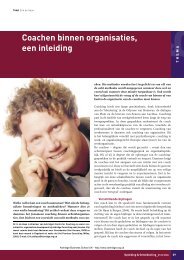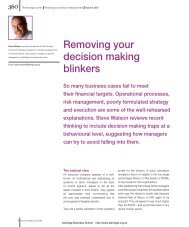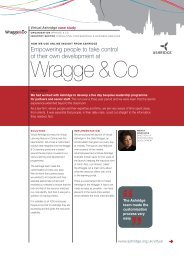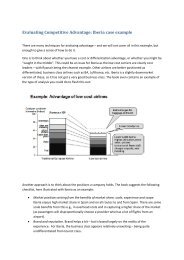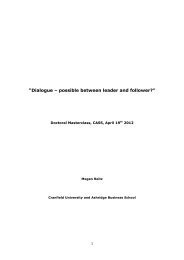IBERIA CASE STUDY - Ashridge
IBERIA CASE STUDY - Ashridge
IBERIA CASE STUDY - Ashridge
Create successful ePaper yourself
Turn your PDF publications into a flip-book with our unique Google optimized e-Paper software.
<strong>IBERIA</strong> <strong>CASE</strong> <strong>STUDY</strong><br />
Iberia was founded on June 28, 1927 by Horacio Echeberrieta. It was not only Spain’s first airline,<br />
but also the first to fly between Europe and South America (as of 1946), the first to establish a walk‐<br />
on air shuttle service (between Madrid and Barcelona), and the first in Europe to offer an<br />
international frequent flyers customer loyalty programme (Iberia Plus).<br />
In 2001, on April 3, Iberia’s privatization process was completed, when its shares were listed for the<br />
first time on the stock exchange. The following year Iberia was included in the selective Ibex‐35<br />
stock market index. Today Iberia is an international transport group operating in around 100<br />
airports.<br />
<strong>IBERIA</strong>’S POSITION SHORTLY AFTER PRIVATISATION (2002)<br />
Although Spain is not a major airline hub, it is a rapidly growing market:<br />
FAST GROWING SPANISH MARKET<br />
Iberia case study 1
Iberia revenues are split roughly 1/3, 1/3, 1/3 across three market segments: Domestic, European<br />
and Long haul/Intercontinental:<br />
• Spain has more domestic passengers than any other European country. Its large size and<br />
relatively undeveloped road and rail infrastructure outweigh the impact of being smaller in<br />
population than some other countries. The case majority of customers fly point to point (i.e.,<br />
not through a hub such as Madrid). The domestic market has relatively few competitors on<br />
most routes, but is forecast to decline due to improvements in motorway and rail links. Iberia<br />
enjoys market shares of 50‐60%, and 85% in the premium segment. It has good relationships<br />
with the local airports and related local government and this allows it significant influence over<br />
departure times, gates and plans for airport expansion and modification.<br />
• The European market is also large in Spain. Germany‐Spain has the largest number of flights of<br />
any two European countries – with UK‐Spain second. The majority of passengers fly on point to<br />
point routes, although slightly less so than for the domestic market. European flights face<br />
increasing competition from LCCs (low cast carriers) such as Ryanair, particularly to and from<br />
tourist destinations. Spain is tied with Italy as the second most penetrated LCC market after the<br />
UK. However, to date the LCCs have taken share primarily from Charter airlines.<br />
Competitiveness varies a lot by route – but in general, high traffic routes attract new<br />
competitors over time. There are no major regulatory barriers stopping a new airline starting up<br />
– although they can find it difficult to find slots at very busy airports such as Heathrow or<br />
Madrid.<br />
• Long haul markets have been hit by the recent twin towers bombing in New York, but are<br />
expected to recover. Iberia serves the needs of domestic travelers and has the highest market<br />
share (for European airlines) in routes to Latin America. Its share of tourist and business<br />
customers are about equal (the latter having grown significantly in recent years). Some airlines<br />
are contracting, such as BA. Several of the Latin American airlines have experienced severe<br />
problems related to the meltdown of some Latin American economies in recent years.<br />
The majority of passengers fly on connecting flights to Madrid or Barcelona before flying to<br />
their final destination – although a significant number fly point to point (i.e., direct from Madrid<br />
and Barcelona). On routes from Spain to Latin American, as on routes to many other inter‐<br />
continental markets such as the US, government regulation means that Iberia is the only<br />
European airline allowed to fly.<br />
Examples of prices for different routes in these three different markets are attached as an appendix.<br />
Iberia case study 2
MARKET SHARE EVOLUTION EUROPE‐LATIN AMERICA<br />
16.0%<br />
14.0%<br />
12.0%<br />
10.0%<br />
8.0%<br />
6.0%<br />
1998 1999 2000 2001 2002<br />
Iberia<br />
• More destinations<br />
• Higher numbers of non-stop flights<br />
• Higher daily frequency<br />
Air France<br />
KLM<br />
British Airways<br />
• Retrenching to business and point to<br />
point customers only<br />
Lufthansa<br />
Source: Iberia.com<br />
Iberia’s operational performance is mixed. Costs are high relative to the low cost carriers. However,<br />
unit costs are low relative to other national carriers.<br />
<strong>IBERIA</strong> UNIT COSTS BELOW TRADITIONAL AIRLINES<br />
Costs<br />
(Euro<br />
Cents/<br />
ASK**)<br />
14<br />
13<br />
12<br />
11<br />
10<br />
9<br />
8<br />
7<br />
6<br />
5<br />
SAS<br />
Low Cost Carriers<br />
EasyJet<br />
Ryan Air<br />
Lufthansa<br />
Air France<br />
Iberia<br />
600 800 1.000 1.200 1.400<br />
Iberia case study 3<br />
Average Stage Length (Kms)<br />
Austrian Airlines<br />
British Airways<br />
KLM<br />
1.600 1.800 2.000<br />
Date for period January – December 2002, except Ryanair and Easyjet fiscal year 2002.<br />
** Costs are Operating costs less 33% of Operating Leases. ASK is the number of seats<br />
times distance flown (a unit of capacity) Source: AEA, Iberia.com
More specifically (on the parameters identified in the note on the airline business):<br />
• NETWORK. Iberia has two major hubs – Madrid (which is the biggest for inter‐<br />
continental flights) and Barcelona. It is particularly strong in Madrid (in excess of 50%<br />
market share), which is relatively business orientated and the prime hub for inter‐<br />
continental flights. Both hubs have experienced high growth and are expected to<br />
continue to show this. However, LCCs are building share at Barcelona in particular, and<br />
other Spanish airports such as Malaga and Alicante.<br />
Iberia operates many flights from Spain to European locations and to major inter‐<br />
continental hubs – particularly Latin America where it has a high share of total flights. It<br />
has also been increasing the proportion of business customers on these routes.<br />
• POSITIONING/BRANDING. Iberia is the premium airline in Spain. Recent initiatives<br />
include strong growth of its European network, launching Iberia.com and electronic<br />
ticketing, e‐procurement and initial reduction in staff costs. It has a traditional model,<br />
including branding, frequent flyer programs (as part of the OneWorld alliance), business<br />
lounges, on board catering, traditional seating (spaced out, limited recline in business), a<br />
relatively undifferentiated service between business and tourist class customers, heavy<br />
use of travel agents and relatively high commissions (10%)<br />
Aircraft utilisation is particularly poor – primarily due to network planning and slow<br />
turnarounds.<br />
• ALLLIANCES. Iberia is a member of the OneWorld airline alliance along with American<br />
Airlines, British Airways, Aer Lingus, LAN Chile, Cathay Pacific, Finnair and Qantas.<br />
Together they fly to almost 600 destinations in 135 countries. On average, every five<br />
seconds there is a takeoff or landing by an aircraft of an airline in the alliance.<br />
• AIRCRAFT MIX. The fleet is a mix of Boeing and Airbus aircraft.<br />
• OUTSOURCING. Iberia has not outsourced many of its activities<br />
• SYSTEM DEVELOPMENT. Iberia does not have any other major businesses<br />
Iberia is a relatively profitable airline and has been for the past few years.<br />
Sources: Iberia Website, Press.<br />
Iberia case study 4
LOWEST PRICES OF <strong>IBERIA</strong> FLIGHTS FROM MADRID<br />
Outbound flights Monday 19 June, 2006 – booked one month in advance<br />
Distance Overnight 4 day stay<br />
Destination<br />
(Km) stay (Euros) (Euros) Notes<br />
Granada (Spain) 310 262 104<br />
Murcia (Spain) 300 452 104<br />
Geneva 1200 55 70 350 Euro for a day return<br />
London 1650 66 168<br />
New York 5800 1820 1121 506 Euro for Friday or<br />
Rio de Janiero 7000 3753 1149<br />
Guatemala 7500 3048 4258<br />
LOWEST PRICES OF <strong>IBERIA</strong> FLIGHTS FROM BARCELONA<br />
Outbound flights Monday 19 June, 2006 – booked one month in advance<br />
Iberia case study 5<br />
Saturday departure<br />
Distance Overnight 4 day stay<br />
Destination<br />
(Km) stay (Euros) (Euros) Notes<br />
Granada (Spain) 620 298 150<br />
Murcia (Spain) 420 388 104 Via Madrid<br />
Geneva 750 339 179<br />
London 1600 171 235<br />
New York 5800+ 1820 1200 Via Madrid<br />
Rio de Janiero 7000+ 3753 1228 Via Madrid<br />
Guatemala 7500+ 3048 4253 Via Madrid



